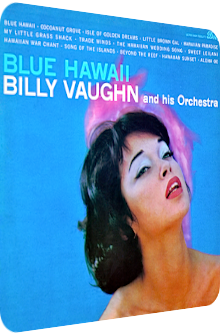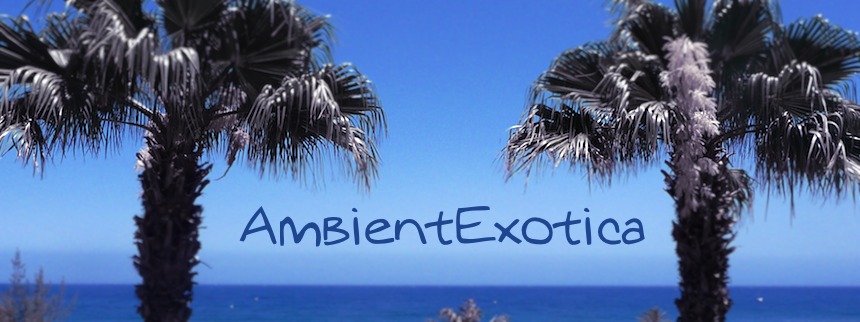
Billy Vaughn
Blue Hawaii
1959
Ukulele player, arranger and conductor Billy Vaughn (1919–1991) wanted to deliver an Exotica album in 1959 on Dot Records without neglecting his beloved Country style, that's the basic premise which, naturally, is poeticized and transfigured in the liner notes. The result is called Blue Hawaii and delivers the schmaltziest horn sections you can possibly find on any Exotica-related vintage LP of the 50's or 60's. There are good reasons to link this work to the Exotica canon, and at the same time, there are strong counter-arguments which repudiate just that. I am willed to put it near the genre for reasons you're going to find out during the review.
Let's just say for now that Billy Vaughn failed miserably in virtually all regards. Of course, the liner notes try to lure the listener with colorful sentences, but they taste all the more sour and bitter once he or she accomplished to wade through the whole album. Without any further quibble of mine, I'll dive deeper into the whopping amount of fourteen compositions below, but close this opening paragraph with a section off the liner notes and ask you to keep it in mind: "How enchanting to mainlanders is the vision of Hawaii, where caressing tradewinds flow gently across palm-shaded lawns, sunbathers bask dreamily on the sands of Waikiki, and the surf murmurs softly and rhythmically!"
The album launches with the titular Blue Hawaii, the composition of Leo Robin and Ralph Rainger that was made world-famous by Bing Crosby in 1937. Vaughn's interpretation sounds like it was delivered by Werner Müller, as it has the typical German feel to it: silky polyphonous horns, accompanying bass tubas, further brazen big band sections and the occasional complemental piano chords. And this very formula is maintained throughout the album, with only a few alterations. Harry Owens' Hawaiian Paradise adds a crunchy guitar and a sun-soaked ukulele to its double bass-backed brass extravaganza, bringing the prototypical Hawaiian feeling to the table for the first time, and Don McDiarmid's and Lee Wood's Little Brown Girl enhances the formula with a Dixieland-like setup and a humming mixed choir; the best things are the cool guitar backings and the intermixed piano, but that's about it. The Hawaiian feeling is nil.
Walter Blaufuss' My Isle Of Golden Dreams is so disgusting that it is actually great. Rarely do I use such harsh words in my reviews – here's a reminder of My 5 Golden Rules – but Vaughn's try is nothing short of a joke: piles of horns paint a German alpine vista, and even if Billy Vaughn plucks along with his ukulele to the aah-aahing choir, there is not even a glimpse of a successful synergy perceptible. It's getting better, though! Charles E. King's Hawaiian Wedding Song is presented flawlessly here, with lots of dreamy steel guitar twangs, ukulele licks and a cornily humming choir that actually augments the clichéd reverie. The trumpets and muted trombones are still on here, but much reduced and less important.
The only great song out of seven on side A, for Harry Owens’ second featured song, Sweet Leilani of 1934, boosts the saccharine levels of the horns to hazardous proportions and makes things worse due to the mellow cymbals and piercing horns, with only the final vibraphone-esque note leaving a good impression. And don't get me started on the final piece of side A, John Sebastian's auspicious Cocoanut Grove which hides its wonderful guitar base frame and ukulele skeleton under one too many brass instruments and a spectral choir. Only the middle section puts the guitars to the forefront.
Side B offers more of the same, I'm afraid: Trade Winds is germanized with too much trumpets, but beneath their surface glint wonderful vibraphone droplets which are then coupled with a cool steel guitar. Listening to both of them in adjacency to the choir and the trumpets makes me all the more sad, as the potential of Trade Winds is completely gone. Billy Vaughn's take on Jack Pitman's Beyond The Reef, however, is actually quite good! The dreaminess is expanded with the wondrously warped twangs of steel guitars, the plasticity of the ukuleles, mild double bass lines and the humming choir. The horns are surprisingly fitting this time, making this the best track of side B.
Tommy Harrison's and Johnny Noble's My Little Grass Shack is yet another good outing due to its iridescent vibraphones, Honky Tonk pianos and the theremin-like steel guitar goodness, expanding the instrumental pool to great success. The humming choir is brought back, and its inclusion isn't embarrassing at all, but somehow fits into the scenery in a weirdly twisted way. Good work, I say! The second featured tune by Charles E. King is next, Song Of The Islands written in 1930. It's a highly ephemeral brass song with a syrupy Schlager euphony that is still so totally out of place that it remains astonishing to me even after 11 tracks, with three more to follow: the traditional Hawaiian War Chant meshes lackluster, pale drums with the well-known bad joke of swinging Folk music. The woeful blueprint is wearing cumbersome on this point, but thank the tiki gods for the looming end of this LP, as the penultimate Hawaiian Sunset ends the brass panopticon with gleaming vibraphones, the melting schmaltz of the choir and the despised horns.
The final piece is… well…? Aloha Oe, of course. The main melody is played on two trumpets, with added tremolo ornaments that make things worse. The choir is breathing the last aahs, as Billy Vaughn says good-bye with the help of spiraling piano sprinkles and an actually great steel guitar dreaminess. It's over!
Seriously, if there is one record that destroys and trashes the characteristic traits of brass instruments, it's Billy Vaughn's Blue Hawaii. And don't you tell me that this isn't a proper Exotica record! I mean, you're right, but the promises, release date, cover artwork, delivered material and used instruments evoke anything but an Exotica outing. But no, Vaughn destroys the good mood, phantasmagoria and mirage of each and every track on there. Even the briefly mentioned Werner Müller doesn't inject such an overly gargantuan dose of German mannerisms and Folk styles. The vibraphones, ukuleles, steel guitars and pianos don't have a single chance to fight or actually declare victory over the horn heaviness. The humming choir is an audacity, as are the poorly revved up drums on Hawaiian War Chant which sound just the least bit more powerful than on all the other included tracks. Translation: yawn!
If there are people out there who are fond of this work and actually shake their head in disdain because of the harshness in this review, please take my sincere apologies, but I do believe that Billy Vaughn tried to cash in on the Exotica craze by aiming at certain audio-visual triggers and then negating them once the record is spinning. The liner notes are a frivolity: "a swaying couple can suddenly imagine themselves beneath a starry sky, with moonlight silhouetting Diamond Head and touching the restless sea with silver." Come on, not with Billy Vaughn's Blue Hawaii, that is not possible. Well, that is all I have to say about this bad Exotica/Folk/Country concoction. The best song of side A is the Hawaiian Wedding Song, and side B delivers a trace of greatness due to the dreaminess of Beyond The Reef, with My Little Grass Shack reaching a close second place. Avoid the album, even if you already own it. I inherited it, but yeah, I admit that this is a lame excuse.
Exotica Review 123: Billy Vaughn – Blue Hawaii (1959). Originally published on Sep. 22, 2012 at AmbientExotica.com.
